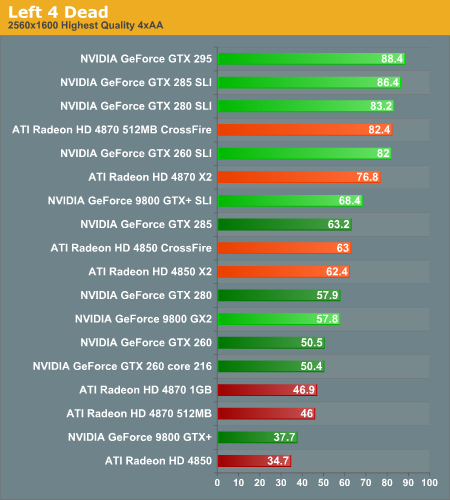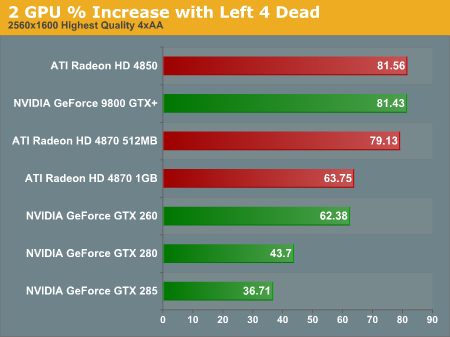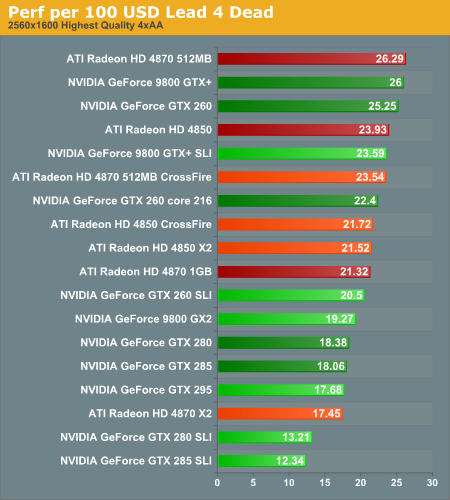MultiGPU Update: Two-GPU Options in Depth
by Derek Wilson on February 23, 2009 7:30 AM EST- Posted in
- GPUs
Left 4 Dead Analysis
Based on Valve's Source engine, Left 4 Dead can run fairly smoothly with any card we tested at any resolution with the maximum settings. The game is definitely not bad looking either, so getting playable framerates on the Radeon HD 4850 at 2560x1600 is no small feat. We do test with a custom demo that makes use of a heavy swarm of zombies in an outdoor area, and though the performance impact is as heavy as we could make it in our benchmark, it may still be possible to hit situations where the lowest end cards stutter with lots of enemies around at very high resolution.

1680x1050 1920x1200 2560x1600
At 1680x1050 and 1920x1200, CrossFire and single ATI cards tend to do better than their NVIDIA counterparts. The GTX 295 does hang out near the top, though. Oddly, the 9800 GTX+ SLI does better than GT200 2 card solutions. If it were just the single card GTX 295 that performed better than the two card options, we would speculate that there was some bus bandwidth or latency issue that caused problems, but it seems that there's something else limiting the performance of the NVIDIA GT200 SLI options. Of course, with the high framerates we see, we aren't exactly complaining. We recommend turning on triple buffering for this game to both eliminate tearing and minimize the input latency possible when just enabling vsync.

1680x1050 1920x1200 2560x1600
Performance at 2560x1600 shirts the playing field putting SLI and CrossFire on more equal footing. While NVIDIA's GTX 260 options lead the competing 4870 class options, the 4850 does very well against its competition. There are no real disappointments with this game and any multiGPU solution though.
When it comes to scaling, at lower resolutions we see CPU/system limited performance affecting the improvement possible with multiple GPUs. The 9800 GTX and 4850 are the only cards that see any real improvement at 1680x1050, and it's not even that much better at 1920x1200. Moving up to 2560x1600 we finally see most of the players above 50% scaling. The exceptions are the fastest single GPU configurations in this test: the GTX 280 and GTX 285.

1680x1050 1920x1200 2560x1600
Between the two "low" resolutions we test, there's no change in the value lineup even though there are shifts in the performance lineup. At these resolutions, multiGPU options tend not to be a good investment because of the CPU/system limit issue. The exception are the 4850 CrossFire and 9800 GTX+ SLI because of the fact that the single card options are GPU limited and we see better scaling for the money with two GPUs. At higher resolution, value compresses more and the 4870 1GB drops in value while NVIDIA hardware pushes up a bit.










95 Comments
View All Comments
Nighttrojan - Wednesday, February 25, 2009 - link
Well, the problem is that I tried it at the same settings too, the 7600gt was still faster. The difference is so great that it takes about 15s for the 4870 to even process a change in settings while with the 7600 gt it's practically instant.mrmarks - Tuesday, February 24, 2009 - link
Is bolting two video cards together really necessary? I've played Call of Duty at max settings on my two year old midrange card and it ran beautifully. These cards seemed to be designed for games not of today or tomorrow, but rather for games that may never exist. Few store fronts sell pc games today, and many of the games produced today are not terribly graphics intensive. Also, most popular pc games are available on consoles, which are much more practical. I know this sounds negative but the truth is that the video card manufactures are just ignoring the current pc game market.SiliconDoc - Wednesday, March 18, 2009 - link
Geeze dude, there are hundreds of PC games out every year. I suppose the couch console has a wider selection, but it's not like we're dead space here. (hahah)I guess it's easier to sell to Santa for the little curtain climbers when even Daddy has a resistence problem. ( Believe me, it's a standing joke amongst friends).
Then we have the kiddies screwing up the computer issue - not a problem when the household heads do so... the console keeps the PC functional, so to speak.
But really, lots of game choices for the PC - the biggest retailer in the USA - you know whom - has loads of PC games. Ever heard of best buy - aww just forget it.
Just go whine somewhere else would ya ?
Elfear - Tuesday, February 24, 2009 - link
^ Go take a 2nd look at the 2560x1600 res graphs. In almost every case the single cards are struggling to keep their heads above water and in a few cases failing miserably. Ideally, minimum framerates would be >60fps in all of today's games for that buttery-smooth feel but we are far from that with even dual graphics cards.I agree with you that dual graphics cards are not needed by most gamers but to say that there is no need period is ignoring reality.
JPForums - Tuesday, February 24, 2009 - link
I'm confused about your opinion on AMD drivers. You made this comment in this article:"Because of AMD's driver issues, we often have to wait when new games come out to enjoy proper CrossFire scaling with them. And when hotfixes come out it takes more than a month (usually more like two) to fully integrate changes into a WHQL driver."
However, you've also made comments in multiple articles similar to this one from GPU Transcoding Throwdown: Elemental's Badaboom vs. AMD's Avivo Video Converter on December 15th, 2008:
"The train wreck that has been the last few months of Catalyst has happened before and it will happen again as long as AMD puts too many resources into pushing drivers out every month and not enough into making sure those drivers are of high enough quality."
So on the one hand it seems you are criticizing AMD for not releasing WHQL drivers soon enough. While on the other hand, you seem to want them to take more time with their drivers. Anandtech is not the kind of site to post contradicting opinions on a whim, so I have to assume that your opinion simply hasn't been stated clearly (or I just missed it).
I remember a comment from an article to the effect of nVidia has a good driver release model. It is interesting to note that nVidia's driver release schedule over the last 6+ months hasn't been all that different from AMD's schedule.
nVidia's driver release schedule:
182.06 February 18, 2009
181.22 January 22, 2009
181.20 January 8, 2009
180.48 November 19, 2008
178.24 October 15, 2008
178.13 September 25, 2008
177.41 June 26, 2008
177.35 June 17, 2008
182.05b February 10, 2009
181.22b January 16, 2009
While nVidia doesn't have a specific release data, they have on average put an update out nearly every month. Being a user of more nVidia hardware than AMD hardware I know that nVidia uses beta drivers in a similar fashion to how AMD uses hot fixes.
In my opinion, AMD needs to ditch the set release date. They should try to target updates about once a month, but release them only when they are ready. I do think their driver team is likely understaffed, but I a think nVidia's The Way it's Meant to be Played program plays a significant role in why nVidia can support certain games well at launch and AMD can't. Though, I can't say whether it's simply good nVidia developer relations or forced negligence towards AMD. I don't really have a problem with them releasing hotfixes, especially given that AMD has had issues supporting some games at launch, but if their driver team and/or developer relations were better, they wouldn't need them as often.
I would, like to hear more clearly stated opinions from Derek and Anand on this subject. Thanks.
SiliconDoc - Wednesday, March 18, 2009 - link
Here's a clearly stated opinion. ATI KEEPS ******* IT UP, while their competition does a good job.Patrick Wolf - Tuesday, February 24, 2009 - link
What's the word on overclocking these multi-gpu setups? I can only speak for the 9800 GX2 but it's a very good OCer. EVGA GX2's lowest end model is 600/1500/1000. The SSC edition is 675/?/1100. Same card, just factory overclocked.I was running the lowest end model @ a stable 715/1787/1050 Currently testing out 720/1800/1065 (w/ the GX2's cover removed) with good results.
mpk1980 - Tuesday, February 24, 2009 - link
i think the 2 gtx 260's in Sli are a good value right now...that setup comes in the top of the charts most of the time competing with the 280 and 285 sli setups and right now...can be had for less than 400 at newegg after rebate (380ish i believe) which is just as cheap at 1 gtx 285 and 120 cheaper than a 295.....i dont think you can go wrong with that right now....and i cant wait to see 3 of those badboys in tri sli :)gigahertz20 - Monday, February 23, 2009 - link
Very few people (like around 1%) that read this article play games at 2560x1600, because that resolution requires a CRT monitor or a super high end LCD monitor (not even sure where to get an LCD that goes that high). I realize this article wanted to push the SLI and crossfire video card configurations and see what kind of FPS they would get at that resolution, but the FPS graphs in this article should be set at 1920x1200 by default, not 2560x1600, since that resolution is useless to almost every gamer.7Enigma - Tuesday, February 24, 2009 - link
I think the point was to show that UNLESS you are running >24" monitors there is no REASON to have CF/SLI. I would normally agree with you but in this particular review I agree with the writer.I still think the broken line graphs showing all resolutions on the same x/y axis was more beneficial.